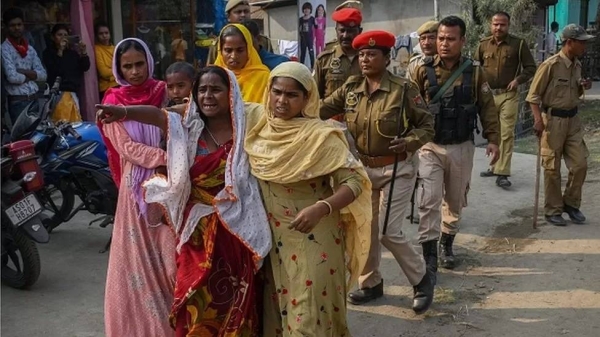
In July, a video began circulating online of an altercation between two women on a Tehran bus. One, in full hijab, attacks the other, a 28-year-old called Sepideh Rashno, for not wearing a hijab, mandated under Iranian law and punishable with a fine or even prison.
In the weeks leading up to the incident, footage of similar episodes had been spreading with increased frequency online, evidence of the growing pressure being exerted on women by the regime. But this particular video went viral, and led to Rashno being arrested, abused and forced into making an apology on state television.
For a few weeks, Rashno was the face of a crackdown on women’s freedom in Iran that has intensified, sometimes violently, in the last year. Her arrest was “a turning point for many women who had been resisting the morality police and fighting the mandatory hijab and slowly pushing the limits of what the state considered proper attire, and slowly but gradually making progress in pushing those limits,” says Negar Mortazavi, an Iranian journalist and political analyst.
“But this was a reminder of the state’s violent enforcement of the mandatory hijab on women. It was seen as a message to those who resist the state’s mandatory dress code. But it had the opposite effect, and anger and fury that had been slowly building up over decades eventually exploded with the subsequent death of Mahsa Amini in the custody of the morality police,” she says.
When news broke that the 22-year-old had died after being arrested for wearing her headscarf “improperly”, protests that began outside the hospital where she died spread across Iran within a week. Women burned their headscarves and cut their hair, leading the protests in which thousands of Iranians demanded the end of Ayatollah Khamenei’s rule and chanted Amini’s name.
“The horrific murder of Mahsa exposed the brutal reality of life under the Islamic republic,” says Kasra Aarabi, the Iran programme lead at the Tony Blair Institute, the former British prime minister’s thinktank. “And you can see that these protests – triggered by what happened to Mahsa – are distinctively anti-regime,” says Aarabi.
“Women have been on the frontlines of protests in Iran before,” says Aarabi. “But this isn’t about reform, it’s about outright regime change. Because the compulsory hijab, in the Islamic republic, is not just a piece of cloth. It’s one of the key pillars of the ideology of this regime.”
One of the most striking images of these protests is the sight of schoolgirls ejecting officials from school grounds, or hanging signs that read “woman, life, freedom” in classrooms. “It takes immense courage and bravery for any woman to do this, but especially for young girls who are risking arrest, expulsion from school, and even death when joining these protests,” says Mortazavi.
Among the hundreds of people who have reportedly been killed by state security during these protests is Nika Shakarami, a 16-year-old whose death has been shrouded in disinformation. Confusing and contradictory details emerged about how and when she had died, and her family have described being threatened for going public about her death.
Her mother told journalists she received a call from Nika who said she was running away from security officials before her phone went dead. The family went looking for her at hospitals and police stations but were told they had no one with that name. Meanwhile, videos of her singing and joking around were shared around the world.
Nine days later, the police showed images to her mother to confirm that the dead body in the photograph was Nika. “Her cheeks were broken. Her teeth were broken. She had received a severe blow behind her head, and her skull was dented,” her mother said.
The Iranian government says Nika was thrown from the top of a building and died and that it is a criminal matter and has nothing to do with the protests and security forces. In her burial certificate, obtained by BBC Persian, the cause of death is stated as multiple blows caused by a hard object.
“This has been part of the regime’s playbook in previous crackdowns of mass protests where security forces commit brutal violence against protesters, while denying that violence and those who are killed by it. It happened in 2009 with the state trying to deny that Neda Agha-Soltan and other protesters were killed by security forces, it happened again in 2019.”
“In all instances, the state has tried to create alternative narratives and pressure families into accepting and repeating those narratives. The most recent case was with the Ukrainian plane which was shot down by the IRGC [Islamic Revolutionary Guard Corps] but state officials lied about it for three days. But time and again, these alternative narratives have been challenged and debunked, and Iranians have gradually lost their trust in the state.”
Though young protesters continue to be killed and arrested by security officials, schoolgirls rebelling against the hijab or shouting “Basij get lost!” from school buildings presents a “huge dilemma” for the regime, according to Prof Ali Ansari, a specialist in Middle Eastern history. “What are they going to do with them? They can’t shoot a bunch of schoolgirls.”
Aarabi says: “For the past 43 years, the Islamic Republic has exploited schools as a means to nurture its hardline ideology, as a means to brainwash the future generation to support the regime.” What the protesting schoolgirls show is “it has wholeheartedly failed”.
What we are witnessing now, says Aarabi, is the “beginning of the end of the regime”.











